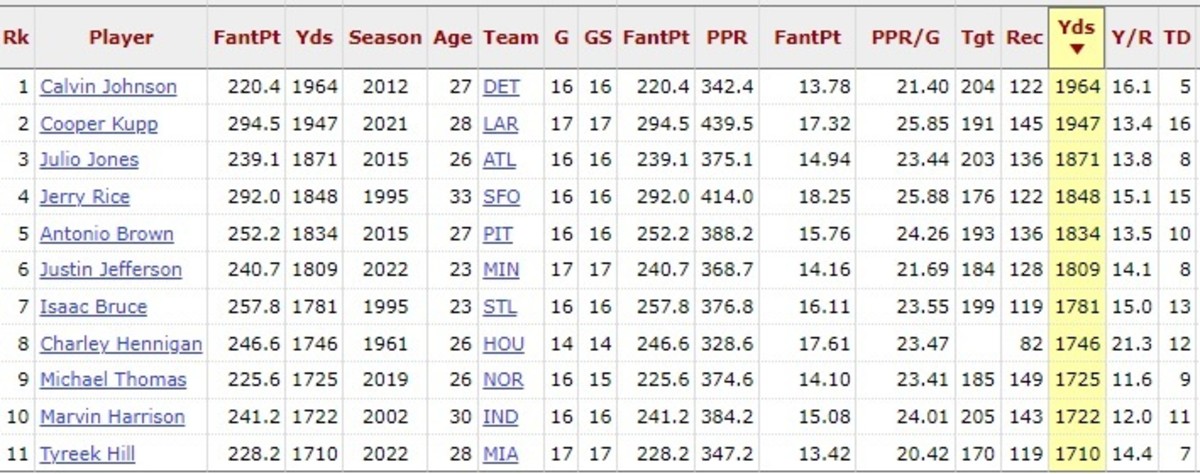Here’s Why Justin Jefferson and Tyreek Hill Might Show Regression in 2023

The NFL has become more of a passing league than ever, and we’re seeing the results of this switch in fantasy football. Wide receivers are going higher and are in more demand in drafts, which is evident in my recent one-man, 10-round mock. Round 1 features five wide receivers, including three in the first four picks, with Justin Jefferson at the top as the No. 1 overall selection. Tyreek Hill came off the board at No. 6 overall.
What do those wideouts have in common, besides being fantasy superstars? Well, they’re also just the second pair of wideouts to ever post at least 1,700 yards in the same season. The first such occurrence came in 2015, when Julio Jones (1,871) and Antonio Brown (1,834) both went over 1,800 receiving yards. In all, just 10 receivers have produced over 1,700 yards in the Super Bowl era.

That’s not much.
So, what can we learn from those performances? Was there major regression or any at all in the follow-up seasons? And if so, are we too confident that Jefferson and Hill can duplicate such impressive statistical seasons as we look ahead to 2023?
Let’s take a look, starting with Calvin Johnson. In 2012, he produced an NFL-record 1,964 yards and averaged 122.8 yards and 21.4 PPR points per game. The following season, he produced 1,492 receiving yards (106.6 YPG) in 14 games and averaged 21.6 points per game. That was due to his increase in touchdown catches from just five in 2012 to 12 in 2013. Overall, Megatron met his expectations.
As you’ll learn, though, Johnson is the exception to the trend.
Next is Cooper Kupp (2021), who had 1,947 yards, averaged 114.5 yards and 25.9 points per game in what was the best fantasy season ever from a wideout. He was unable to duplicate those totals the following year, as he missed eight games due to injuries. While he still averaged an impressive 22.4 points, his yardage per game average fell to 90.2. That’s 24.5 yards fewer per game than he averaged in 2021.
In order of receiving yards, Jones is next with 1,871 yards in 2015. He put up an average of 116.9 yards and 23.4 points per game. While his numbers were still solid the following season, Jones saw declines across the board. He averaged 10.3 fewer yards and 4.8 fewer points per game, and he missed two contests as well.
Noticing a trend? And even the greatest wideout of all time couldn’t avoid it.

That wideout, of course, is Jerry Rice. In 1995, he had 1,848 yards and averaged 115.5 yards and 25.9 points per contest. Those were bananas numbers in the mid-1990s. But Rice saw his numbers decline the following year, as he recorded just 1,254 yards, 78.4 yards and 18.4 points per game. That’s a drop of 594 yards over the course of the season (16 games), 37.1 yards and 7.5 points per game.
Brown is next up, as he went off for 1,834 yards and averaged 114.6 yards and 24.3 points per game in 2015. The following year, he was the consensus No. 1 overall pick. It was rare for a wideout to hold that title at the time, and Brown was solid in the stat sheets. But like most of the others, his numbers declined. His yardage fell 550 yards, his yards per game dropped to 85.6 and his points per game fell to 20.5. Again, all very good numbers but not on the same level as his previous campaign.
The other three receivers who have gone over 1,700 yards in a single season are Isaac Bruce (1995), Michael Thomas (2019) and Marvin Harrison (2002). All three saw their numbers decline the following year. Bruce dropped 443 yards, 27.7 yards and 7.5 points per game. Thomas got hurt in 2020 and hasn’t been the same since, and Harrison dropped 450 yards, 22.8 yards and 5.5 fantasy points per contest.
Now let’s look at the final numbers from six of the eight wideouts in our research. I’m excluding Kupp and Thomas, because both players missed eight or more games the season after their 1,700-plus yards campaign. The average decline in yards among the rest is 495.2 total receiving yards, 23.9 yards and 4.8 PPR points per game.
To reiterate, these declines happened to Rice and some of the best wideouts of all time. This isn’t a list of one-hit wonders or curtain jerkers, these are the superstars who in most cases already have (or will have) their busts in Canton.
If we assume similar fates for Jefferson and Hill, are we overvaluing them in drafts?
I would suggest no, but I also think we should learn from the past and temper those pie-in-the-sky expectations compared to last season. If we take the average declines of our six historical receivers, Jefferson will project for 1,681 yards and 282.2 points. Hill’s projections would be 1,304 yards and 265.2 points. Those would be top-eight totals among wideouts, but they’re not on the same level as their 2022 numbers.
Does this mean I’m avoiding Jefferson and Hill in drafts?
Of course not. Like I said, I have Jefferson as the consensus No. 1 selection and Hill in the top six in my latest mock draft. But based on the past and the fact that the NFL is hugely unpredictable, I’d expect that a repeat of their 2022 totals is unlikely.

